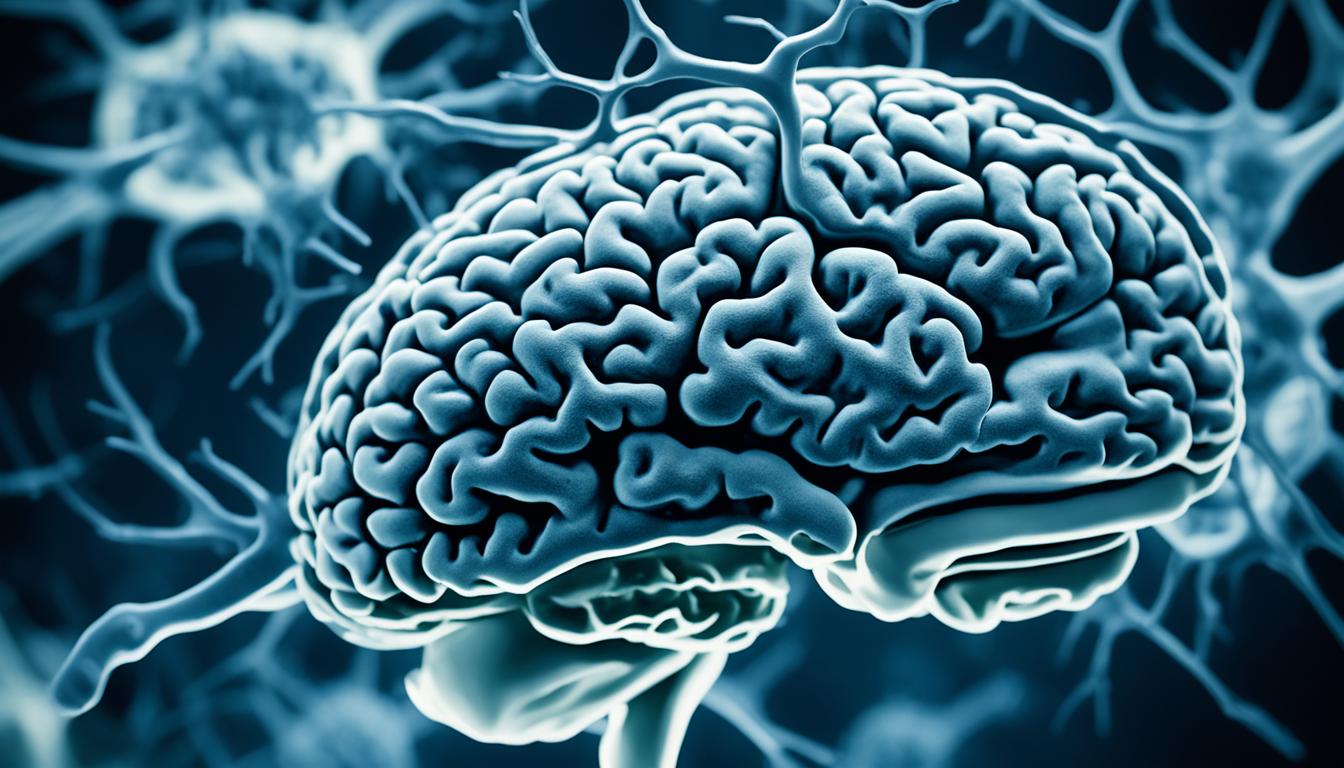Creutzfeldt-Jakob Disease (CJD) is a rare brain disorder caused by faulty prion proteins. It leads to the slow breakdown of brain function. This results in severe problems with thinking and movement.
Many signs point to someone having CJD. These include memory loss, getting confused easily, and acting differently. People may also see things that aren’t there, have trouble moving their muscles, and fall often. As the disease progresses, these symptoms get worse, greatly affecting daily life.
Different types of CJD exist. Sporadic CJD, the most frequent kind, appears for unknown reasons. Genetic CJD comes from mutations passed down by parents. Acquired CJD happens when someone is exposed to infected tissues or certain medical procedures. Lastly, variant CJD comes from eating beef infected with mad cow disease, known as bovine spongiform encephalopathy.
Key Takeaways
- Creutzfeldt-Jakob Disease (CJD) is a rare degenerative brain disorder caused by faulty proteins known as prions.
- The most common symptoms of CJD include forgetfulness, confusion, behavior changes, vision problems, hallucinations, muscle coordination issues, balance problems, uncontrolled muscle movements, seizures, paralysis, and wasting.
- CJD can be classified into different types based on the cause, including sporadic CJD, genetic CJD, acquired CJD, and variant CJD.
- Treatment options for CJD are currently limited, and supportive care is the main approach to managing symptoms and improving the quality of life.
- Ongoing research is exploring potential treatment options for CJD, including experimental therapies like immunotherapy and drug repurposing, as well as stem cell therapy.
Diagnosis and Testing for Creutzfeldt-Jakob Disease
Diagnosing Creutzfeldt-Jakob Disease (CJD) is hard. Its symptoms look like other brain conditions. But, several tests can help doctors figure out if it’s CJD.
1. Cerebrospinal Fluid Analysis
Doctors check cerebrospinal fluid (CSF) for the disease’s proteins. They do a lumbar puncture to get the CSF. Then, they test it in a lab. Finding certain markers in the CSF helps diagnose CJD.
2. Electroencephalogram (EEG)
EEG checks for unusual brain activity. People with CJD often show a distinct abnormal brainwave pattern. It involves putting electrodes on the scalp to record brain waves. Doctors use these patterns to identify CJD.
3. Magnetic Resonance Imaging (MRI)
MRI shows changes in the brain linked to CJD. It takes detailed brain images, showing abnormalities. Doctors look at these images to find signs of CJD and brain damage. This supports making a diagnostic conclusion.
4. Brain Biopsy
Sometimes, a brain biopsy is needed to confirm CJD. It checks for abnormal proteins. Doctors surgically take a tiny brain tissue sample. They examine it under a microscope. This is done when other tests are inconclusive.
Using these tests and a careful look at a person’s history and symptoms can lead to a right CJD diagnosis.
Current Research and Treatment Options for Creutzfeldt-Jakob Disease
There’s no cure for Creutzfeldt-Jakob Disease (CJD) right now. Treatment focuses on easing symptoms and giving care to patients. But, researchers are working hard to find ways to treat CJD.
Experimental Therapies
Some studies are testing new therapies to slow CJD’s progress. For example, immunotherapy uses the immune system to fight off bad prion proteins. This method looks promising in changing the disease’s course and helping patients better.
Repurposing existing drugs is also under study. Scientists want to see if drugs used for other diseases can help with CJD. If successful, this could speed up the use of new treatments without the long wait of making new drugs.
Stem Cell Therapy
Stem cell therapy is a hopeful area for treating CJD. It aims to repair the brain’s damaged tissues and slow down the disease. Stem cells can change into different cell kinds. So, they might replace or fix the neurons harmed by CJD.
Results from early animal studies on stem cell therapy are positive. But, more research is crucial to check if it’s safe and helpful for people.
Supportive Care
While researchers work on new treatments, caring for CJD patients remains vital. This care can include therapy to help with physical coordination and medication for symptoms like anxiety. Also, palliative care offers comfort to both the patient and their family.
Support groups and CJD-focused organizations can also provide help and emotional support. They offer valuable information and a strong sense of community for those affected by the disease.
Conclusion
Creutzfeldt-Jakob Disease (CJD) is a rare, but severe, brain condition. It deeply affects those with it and their families. Getting proper support and resources is very important for anyone dealing with CJD.
Many CJD support groups and organizations offer help. They give important information, emotional support, and fight for CJD patients’ rights. Their work is crucial for those living with this tough condition.
These support groups create a community for those facing CJD. People can share their stories and find comfort with others who understand. Connecting with them can provide useful advice and emotional support.
It’s also important to spread the word about CJD. This helps the public learn more and supports research and treatment efforts. By making CJD more known, we can push for more funding and focus on finding a cure.
Together, by making our voices heard, supporting each other, and pushing for more research, we can improve the lives of those battling CJD. Let’s keep working to make a better future for CJD patients and their loved ones.

